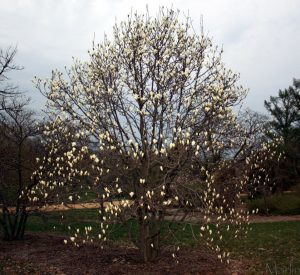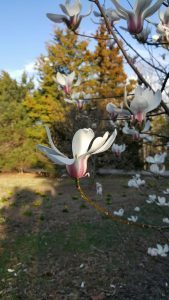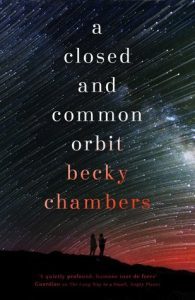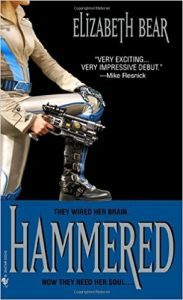Rachel Neumeier's Blog, page 274
March 22, 2017
How to grow spring-flowering magnolias
So here we are in the latter part of March, heading toward April. That means it’s spring, more or less, for a lot of us, right? Here in Missouri we had a very warm and very dry February (excellent for housetraining young puppies), followed by a much (much) colder March. Well, sometimes that happens! But if, like me, you are especially fond of the enormous Magnolia genus, which contains basically all the true aristocrats of the spring garden – I may be a bit biased, but anyway – what should you do if your spring weather is highly variable and uncertain?
You have, I believe, two options:
1) Plant half a dozen trees of just one variety. Better yet, a dozen.
Pick one of the big trees if you have space, one of the small trees / large shrubs if you don’t. I recommend the common saucer magnolia, Magnolia x soulangeana, which is quite flawless in beauty and fragrance. If you prefer something that will puzzle everyone walking or driving by, you might opt for the much (much) rarer Yulan magnolia (M. denudata). For the smaller area, you can’t beat ‘Ann.’ Unless you are not into fuchsia. In that case, perhaps a star magnolia (M. stellata) or the M. x loebneri hybrid, either of which will give you paler and more delicate colors.
[Side note: there are about 200 recognized species in the Magnolia genus. The ones that have an x in the middle of their names, like Magnolia x soulangeana, are hybrids between two or more of these species. Magnolia x soulangeana was produced via a cross between Magnolia denudata x Magnolia liliiflora, for example.]
I have to say, if you have half a dozen – better yet, a dozen – magnolias of one kind all blooming in one yard, you will stop traffic. In a good year.
In a bad year, you will see every. single. flower. turn to brown sludge right before the flowers quite open. Drivers will turn their heads away rather than endure the sight. You will keep your shutters closed for a week or two because you just can’t bear it.
Sound too chancy for you? Then you have another option:
2) Plant half a dozen or a dozen different kinds of magnolias. Although the timing of your magnolias will vary every year, the relative timing should be predictable. You are not so much trying to get trees that bloom after the last spring freeze — the last spring freeze can occur any time from mid-February to late April, and refusing to plant anything that blooms before May means you will miss out on essentially all of the most beautiful magnolias. Instead, you are trying to ensure that no matter what crazy weather you have, at least some of your magnolias will bloom before or after periods of freezing lows.
First to bloom: the Yulan, M. denudata, the lily magnolia, one of the parents of the great saucer magnolia. Click on the photo and it should blow up for you.
These big trees are best appreciated against an evergreen background or with a brick wall behind them or something of that kind. The white flowers are not as showy against the gray branches of deciduous trees or against blue sky as the darker colors. However, the individual flowers are perhaps the most beautiful of all magnolia flowers.
This year the Yulan opened its flowers for me on February 20th. This was during the warm part of February. A cold front shut the Yulan down after four days of glorious bloom. If you don’t think four days of splendor are welcome in late February, well. Although it is, as I say, possibly the most beautiful magnolia, I should add that the Yolan has only the very faintest fragrance.
At the time the Yulan hit its stride, the saucer magnolias were juuuust cracking their buds. ‘Ann’ and the M. stellata and the M x loebneri hybrid and ‘Butterflies’ were buttoned up tight. Thus, the freeze that closed down the Yulan froze the saucer magnolia flowers in the bud and the entire display was lost.
The difference in bloom time between the Yolan and the saucer is about a week. In most years, one or the other will have a chance to bloom. One can’t count on both putting on a show in the same year, not that it doesn’t happen from time to time. If we don’t happen to get a cold front coming through, they’ll be beautiful for ten or twelve days (each).
I will add that in a genus known for precocious bloom, my Yulan took about ten years to bloom. Ten! Years! I thought I might have the only non-blooming Yulan magnolia in the world. It is now beautiful beyond compare, but good heavens, it should be embarrassed, letting tiny baby magnolias bloom all around it.
Second to bloom: A week after the Yulan, the saucer hits its stride. It’s just a matter of whether you beat the cold by blooming before or after a front moves through. This year, the saucer magnolias would have been in full and glorious bloom around February 25th if the weather had cooperated. Honestly, though they’re everywhere, the saucer magnolia is hard to beat. It’s very beautiful in a good year, and the fragrance is lovely.
Third to bloom: Magnolia x loebneri is a cross between M. kobus and M. stellata. It is a little thing, more a shrub than a tree, which holds its little buds tight shut just until the saucer magnolia has had a chance to get zapped. Then it opens up and, surprisingly cold-hardy, puts on a fantastic display of many-petalled unscented flowers for about two weeks unless the nightly lows dip several degrees below freezing. Mine is protected by cedars and so may be a little more cold-hardy than some.
This year, this hybrid opened up on March 2nd and was still blooming its heart out March 10th.
You can see the M stellata genes in the character of the flowers, which are many-petaled. This is my mother’s favorite magnolia.
I will just add here that no Magnolia with a significant percentage of M. stellata genes is going to be as drought tolerant as a saucer or the (many) saucer hybrids. The star magnolia and many of its hybrids respond to severe drought by looking perfectly fine until one morning they suddenly drop all their interior leaves, retaining only the leaves on the tips of the branches. This obviously reduces transpiration and thus conserves water, but jeez, if they would only tell you to get out there with a hose this would not be necessary.
After a leaf-dropping episode, these magnolias will regrow their leaves. I’m not sure they can afford to do this more than once a year, though, so if we have an early drought that pushes them into this grouchy behavior, I will water them during the later drought that we can generally count on during August every year.
In contrast, all the other magnolias just go truckin’ on without missing a beat. So that’s something to keep in mind if you generally get a summer drought. I’ve pretty much sworn off any more magnolias with a lot of star magnolia in them, even though the M x loebneri is particularly nice.
Fourth to bloom: Little ‘Ann.’ Not so little now, but a biiig shrub rather than any kind of tree. I’d guess my mature ‘Ann’ is about, oh, say ten feet high, maybe twelve, and about the same width. This is a saucer hybrid and it shows. ‘Ann’ is only a little behind the M x loebneri hybrid, and in fact not much behind the saucer magnolia. But ‘Ann’ is distinctly more cold tolerant than the saucer and will hold onto something of a display after the saucer has lost every flower. Also, ‘Ann’ will rebloom a bit later in the summer. This isn’t a fantastic show, but it’s something. I will add that Japanese beetles will eat the summer flowers, so if those are a pest for you, don’t get too excited about the reblooming. For us, Japanese beetles kind of come and go. Depends on the year.
I have started two cuttings of ‘Ann’ from my first plant. Here is my baby that is about five or six years old, just about ready to hit its stride, the day before the flowers froze:
Fuchsia is not really my favorite color, and the flowers are not noticeably scented, but despite these drawbacks ‘Ann’ is my favorite magnolia. She is just never any trouble, and most years she puts on a show. Not this year, alas, but I think this is the first time she has completely failed. Plus ‘Ann’ has very dense leaves and looks full right down to the ground. Birds like nesting in her. I have successfully started two cuttings and could find a place to put more, though I would rather try propagating some of the others this spring.
‘Susan’ is supposedly very, very similar in flower but blooms much later, like a month later. I should probably get one to see if it could give me a show in years when the weather shuts ‘Ann’ down. However one problem with the late-blooming magnolias is they will be leafing out before they bloom. The flowers do have more visual impact if the tree blooms before leaves appear.
‘Jane’ is also said to be very similar to ‘Ann’ and blooms, according to books, midway between ‘Ann’ and ‘Susan.’ However, I have a ‘Jane’ and for me it is indistinguishable from ‘Ann,’ so I don’t know if the nursery got mixed up about what they sold me or what. The better nurseries guarantee their stock is true-to-name, but I wouldn’t say I’m sure about this one.
Moving on:
Fifth to bloom: The star magnolia, M. stellata. Mine, a variety called ‘Waterlily’ is very slow-growing and may never get taller than me at this rate. It’s a good choice if you don’t have much space, but I have seen some individual star magnolias that eventually got fairly sizable. The flowers are not fragrant.
Click on the image to blow it up. This picture was taken a couple of years ago, but the shrub is hardly bigger now. I should have posed a dog beside it so you could get the best possible idea of its size. Definitely my smallest magnolia, and I don’t expect it ever to catch up even to ‘Ann.’
Sixth to bloom: The yellow-flowering ‘Butterflies,’ which has flowers that resemble those of saucer magnolias except in color. It’s among the brightest, darkest yellows of the magnolias currently on the market. It’s a hybrid of Magnolia acuminata (the cucumber magnolia – no, I don’t understand the name either) and Magnolia denudata (the Yulan). I imagine it may get to be a sizeable tree given the parents, though mine is a baby.
This year, ‘Butterflies’ would have bloomed around March 12th except that we started getting nights below twenty degrees right then and you know, hardy-flowers-for-a-magnolia does not mean it will take that kind of thing with equanimity. So, nothing this year, alas.
I do have two other spring-flowering magnolias, the blushed white ‘Angelica’ (M cylindrica x M ‘Sawada’s Pink’ – the latter is a Yulan hybrid), and ‘Woodsman’ (M. acuminata x M. liliiflora). Neither of these looks like it’s going to flower this year – they have only been in the ground one full year. We’ll see what kind of growth they put on – I would love to get one or two cuttings of both if I can.
Way later to bloom
If you want to skip lightly over the dangers of spring frosts, Magnolia sieboldii blooms in late spring / early summer.
However, the M. sieboldii is just not all that showy. The flowers are held downward and are partially covered by the leaves. Plus my specimen is not thriving. Too wet last year? To much drought the year before? Hard to say. If it dies, it will be the second of this species I have lost. So I must reluctantly dis-recommend the species unless you are really interested in unusual magnolias and think your thumb is greener than mine. Personally, I am planning to avoid planting any other trees with significant M sieboldii parentage because why court problems?
The Southern magnolia has enormous flowers, and many cultivars are pretty hardy these days, easily hardy enough for Missouri. But as is typical with summer-flowering magnolias, this species really does not put on a show. It opens just a few flowers at a time over an extended period, which is fine, but simply cannot give you the traffic-stopping potential possessed by the showy spring bloomers.
Please Feel Free to Share:









And then the murders began.
You’re familiar with this recent meme, right?
Give the first sentence of a book and then let the second sentence be “And then the murders begin.” It works surprisingly often! (Though definitely not for The White Road of the Moon; so it’s not universally a great second sentence.)
Anyway, here is a post at Book Riot about re-imagining three classic novels as murder mysteries. Not by using the “murders began” line, but just generally recasting the stories as murder mysteries.
Here’s the first:
1. Sense and Sensibility
Exiled from their lavish Sussex home to a small seaside cottage, the Dashwood women are just adapting to their new, simpler life when their good-humored friend and neighbor, Sir John Middleton, is found dead in the woods near Barton Park. It looks like he tripped and hit his head on a rock but a faint set of footprints, quite different from Sir John’s, are found at the site.
After a charming stranger rescues her during a calamitous walk in the rain (taken to avoid the attentions of her would-be suitor, Colonel Brandon), Marianne falls instantly in love. But is John Willoughby everything he claims to be? And what is his connection to Brandon’s ward, whose mysterious disappearance five years ago remains unsolved?
Eleanor, Marianne’s keenly observant elder sister, and the reclusive Colonel Brandon must solve the case and uncover the truth before Marianne becomes the next victim of a cold-blooded killer.
I must say, that is a wonderful set up for a murder mystery. I would totally read that! Click through to see the other re-imagined classics at Book Riot’s post. They also sound thoroughly intriguing.
Northanger Abbey would be (much) too easy. So would Jane Eyre. But how about The Great Gatsby? I bet that one would have been far more interesting to me in high school if it had been a murder mystery. I bet some of Dickens’ work would also make brilliant murder mysteries.
Nothing could have made Madame Bovary readable. Except blowing up the world and turning it into a post-apocalyptic adventure story; that would do it. Drive Madame Bovary right out of her passivity by introducing zombies. I could get behind that.
That’s a whole different topic, I suppose: re-imagining classic novels as post-apocalyptic stories. Picking one that’s already dystopia is cheating. But you know who would shine as the protagonist of a post-apocalyptic novel? The Count of Monte Cristo.
Please Feel Free to Share:









March 21, 2017
What would you tell kids about writing?
Here’s a post by Kathryn Lilley at Kill Zone Blog: What would you tell kids about writing?
She means during a school presentation or something of that sort.
I attended a high school Career Day in South Carolina yesterday, to talk about writing as a possible vocation. I hosted multiple, back-to-back discussions, each one covering different writing-related careers: journalism; fiction writing; and technical writing…
Sounds like a good group of kids, and of course they might have found it interesting to compare the idea of being a novelist with the idea of being, say, a nurse.
Kathryn says she focused on the importance of the craft of writing and the importance of connecting with the local writer’s community. I agree about the former, but the latter seems iffy to me. That’s partly because “local” means something different when you’re this far away from a big city, partly because local is not a very meaningful term in this digitally connected age, and partly because I’m such an introvert that I basically never have followed this advice — certainly not at all before I was actually published. Every budding writer’s mileage will vary, no doubt.
Anyway: what I would say —
Poetic images of The Struggling Poet aside, financial insecurity may well kill your creativity. Even if you can write when under a lot of financial stress, why would you want to? Find a real job that will provide a good cushion and let writing be a hobby until you believe you really are prepared to let it be your only source of income. Which may be never, and that is fine.
Learn to budget, and I mean on the long term, because when you are self-employed you will not BELIEVE how variable your yearly income can be. Budget for taxes first and then for other random huge expenses and sock a lot of money away in good years because there will be years that aren’t so good.
Maybe that’s too practical. But that’s what I would say. And have.
Please Feel Free to Share:









A particularly entertaining book review
Via File 770, a link to this unusual and funny review of A Field Guide to Reality by Joanna Kavenna by Jonathan McCalmont:
One of the ways in which genre reviewing differs from mainstream reviewing is that genre reviewers have traditionally been willing to go after books that get their facts wrong and fail to achieve verisimilitude. It is easy to understand why mainstream reviewing tends to frown on this type of approach as questioning an author’s use of style directs discussion back towards the book while questioning an author’s grasp of how space elevators are supposed to work only ever results in people slapping their slide-rules down on the table.
I mention this as while I think there’s a lot of interesting stuff going on in Joanna Kavenna’s fourth novel, my enjoyment of the book was hampered by my initial urge to disagree with every word of it. In fact, the only thing that kept me from throwing the book across the room was a growing suspicion that I did not so much disagree with A Field Guide to Reality as agree with it far too much.
The slide-rule line is what got me. Actually, the whole review is what got me. It’s hard to choose which bits to quote here.
But how about this:
On a structural level, A Field Guide to Reality is an exquisitely clever piece of writing as Kavenna begins the book on a note of genuine anger at both the elitism of academic institutions and the absolute worthlessness that characterises much of their intellectual output. However, while these cynical notes do come together to form a thematic chord, the chord progression is only allowed to resolve itself at the very end of the novel. This means that while the protagonist is content to swallow every half-baked truth that comes her way, the reader confronts these ideas with the cynicism they deserve. Eliade may believe that she is immersing herself in oceans of beautiful complexity but the reader can quite clearly see her flapping away on the bank vomiting up copious litres of pond. The tension between the cynicism of the novel and the optimism of the book’s protagonist may or may not recall Voltaire’s Candide but it certainly makes for a tense and uncomfortable reading experience.
… Okay. Not sure I have any desire to read the book in question, but I will certainly be keeping an eye out for more reviews by McCalmont. Who is, it seems, a film critic, fan writer, and columnist for Interzone magazine.
McCalmont, incidentally, is part of the “shadow jury” that this year is planning to critique the Clarke Award. I don’t know enough about the regular jury or the “shadow jury” or the Clarke Award itself to have an opinion about any of this, but it’s interesting.
I see this …
…it isn’t our intention that the shadow jury will challenge the decision of the conventional jury; rather the value of the experiment comes, I think, in expanding the commentary. Questions about the state of the field and the underlying definitions of “best” and “science fiction” continue to be meaningful, particularly in an industry that is increasingly dominated by marketing categories and sales figures rather than criticism. What science fiction is and what it ought to be doing should continue to be debated…
… and wonder if it’s possible for a shadow jury to NOT challenge the decision of the conventional jury. I mean, the whole concept involves promoting your shadow jury as somehow superior in its taste to the conventional jury. If not, you wouldn’t ever form a shadow jury in the first place. Would you?
That last bit is Helen Marshall, by the way, announcing the Shadow Clarke. If you’re interested, click through and investigate the various links.
And of course if you were thinking of reading Kavenna’s A Field Guide to Reality, or if you have read it, by all means click through and check out the McCalmont’s review. Or if you’re interested in McCalmont’s criticism and review, you may want to check out his short list for the Shadow Clarke. I’ve actually heard of and kind of want to read one book on this short list: The Many Selves of Katherine North.
Please Feel Free to Share:









Good News Tuesday
Whenever I let something else preempt a Good News Tuesday post, the good news — and the interesting news and the mysterious but cool news — really piles up. Got a lot here this week. Where to start, where to start … maybe with medical good news, always something that catches my eye, as I’m sure you have all noticed.
Here is something that may help a whole lot of people with failing vision:
Organic semiconductor could reverse degenerative blindness
An organic retinal implant designed in Italy can stimulate retinal neurons and send signals to the brain, restoring near-normal vision indefinitely to rats with degenerative blindness without causing apparent damage to the rats’ eyes.
Here’s another article about (I’m pretty sure) the same thing:
Scientists Have Created an Artificial Retina Implant That Could Restore Vision to Millions
And I know we always see “a cure for cancer” right on the horizon, and then it turns out to be more complicated than we had hoped. Still, this is promising:
Cancer Pill Gleevec Keeps Patients Alive and Well for a Decade
Everyone hopes and wishes for that last-minute cancer breakthrough that will save doomed patients. It almost never actually happens. With Gleevec, it did.
The once-a-day pill turned chronic myelogenous leukemia, or CML, from a certain death sentence into a manageable disease. Now data shows it’s helped 83 percent of patients live 10 years or longer.
There are side effects. But shoot, with results like those, this looks like a great start. Given something at works this well, it ought to be possible to come up with related drugs that work even better and with fewer side effects. Faster, please! Far too many of us are going to die of cancer. Let’s see that become a much rarer cause of death — preferably this decade.
The whole article is good — if you have a minute, click through and read the whole thing.
And you know, if all goes well, we will REALLY want cures for all the cancers because we won’t be dying of much else:
Harvard geneticist says CRISPR has potential to reverse effects of aging
That’s a video, so I can’t quote a snippet. But, onward! Let us by all means reverse the effects of aging. This would be a fantastic decade to make major strides in that direction … speaking as someone who is starting to feel her age.
Moving on from medicine, here’s a new development in technology:
German institute successfully tests underwater energy storage sphere
A German research institute has spent years trying to tailor pumped storage to ocean environments. Recently, the institute completed a successful four-week pilot test using a hollow concrete sphere that it placed on the bottom of Lake Constance, a body of water at the foot of the Alps. The sphere has a diameter of three meters and contains a pump and a turbine. Much like traditional pumped storage, when electricity is cheap, water can be pumped out of the sphere, and when it’s scarce, water can be let into the sphere to move the turbine and generate electricity. … In an underwater “energy park,” dozens of these spheres could be connected near an offshore wind farm to create a system that would be able to add extra reliability to a renewable-heavy grid.
This isn’t an area I understand all that well, but it sounds promising. Unreliability of wind power is a big problem. Maybe this could help solve that issue.
And in the category of wild-and-crazy-astronomy, we have this:
Astronomers Just Found a Star Orbiting a Black Hole at 1 Percent the Speed of Light
Astronomers have just spotted a star whizzing around a vast black hole at about 2.5 times the distance between Earth and the Moon, and it takes only half an hour to complete one orbit. … For the black hole to overcome the white dwarf’s own intense gravity, the bodies need to be fairly close together. Over time, as material is stripped away, the now-lighter white dwarf would slip a little further back.
“Eventually so much matter may be pulled away from the white dwarf that it ends up only having the mass of a planet,” said researcher Craig Heinke. “If it keeps losing mass, the white dwarf may completely evaporate.”
Neat, eh?
Also this:
Could Mysterious Cosmic Light Flashes Be Powering Alien Spacecraft?
Bizarre flashes of cosmic light may actually be generated by advanced alien civilizations, as a way to accelerate interstellar spacecraft to tremendous speeds, a new study suggests. … a transmitter capable of generating FRB-like signals could drive an interstellar spacecraft weighing 1 million tons or so, Lingam and Loeb calculated.
“That’s big enough to carry living passengers across interstellar or even intergalactic distances,” Lingam said in the same statement.
Yeah, well, the use of the word “study” in this quote is highly imprecise phrasing, as I think the author of the post simply means, “A team studying fast radio bursts is enjoying wild speculation about their weird findings.”
Still … their findings are pretty weird.
Please Feel Free to Share:









March 20, 2017
Shadowfax vs Bill the pony
I enjoyed this post by Judith Tarr, over at tor.com.
Shadowfax may need magical help to survive the terrain between Rivendell and Moria in winter cold and hard weather without starving to death, but Bill can live off the country and arrive back at Bree both alive and able to recover from the weight loss he’s suffered from living wild in winter. … Pound for pound, too, a pony can be stronger than a horse. Shetlands can carry a grown man with ease, though his feet may drag on the ground. Horses will lose weight-bearing capability as they get larger; a very large horse is challenged enough to carry his own weight around without also carrying a heavy rider.
Okay, sure, 99.9% of all those who watched The Lord of the Rings movies remember Shadowfax better than Bill the pony. But still, an entertaining post where ponies come out a nose ahead of big horses.
Incidentally, my favorite horse in The Lord of the Rings movies was Arwen’s horse, on which she carried Frodo across the river and saved him from the black riders.
What a great scene that was. And the beautiful horse definitely added to it.
Please Feel Free to Share:









Recent Reading: A Closed and Common Orbit
Okay, so, second books are always a bit fraught, right? You liked an author’s first book, maybe you liked it a lot, and here’s the loosely connected sequel and you’re hopeful you’ll like it as well, but who knows?
Of course you all know I really enjoyed Becky Chamber’s debut, The Long Way to a Small, Angry Planet. A rather cheerfully Star Trek-y feel, interesting characters, fairly smooth plotting with interesting and appealing subplots … a rather cumbersome title, but whatever.
I’m not sure I liked the sequel better, but I liked it a lot.
What worked:
A Closed and Common Orbit has a much tighter focus than the first book. There are just two pov characters: the new incarnation of Lovelace, now incorporated in a humanlike body and called Sidra; and Pepper, the woman who has taken Sidra under her wing. Well, except that a large part of the story is told in flashbacks of the young Pepper, at the time called Jane.
Also, the journey was important in the first book; the reader sees a swath of the universe. In the second, the characters stay put, so the local setting is more developed.
The more scattered focus of the first book was okay, but I did like this more limited structure. Both Sidra and Pepper/Jane are good protagonists. It’s easy to sympathize with Sidra, who is having trouble adjusting to being limited to a humanlike body when she used to inhabit a ship. She’s also having trouble figuring out how to relate to organic people. And she hates being dependent on Pepper. All this is totally understandable. Her journey of self-formation and self-discovery is easy to relate to. Also, the thing with the senses is pretty cool
Pepper and her significant other, Blue, hold up their part of the plot as well. Because of the flashbacks, the reader really gets a chance to understand where Pepper is coming from, why she would be so determined to help and protect Sidra, all of that.
What mostly worked:
The incorporation of the flashbacks was not the problem. While reading, it’s easy to keep track of where and when you are. However, the pov of young Pepper/Jane is extremely compelling; so much so that some readers (judging from my own experience) are going to feel a slight wrench whenever her pov switches back to Sidra’s. Nothing against Sidra, but yeah, Jane is going to steal the show.
This kind of thing is probably inevitable whenever you have multiple pov characters.
What worked a little less well:
I guess large-scale slavery and murder must be legal in this universe? I guess there’s some kind of noninterference clause in some legal system where if a particular planet wants to indulge in that kind of thing, everyone else will politely look away? Because I kind of expected that at some point someone would bring down a hammer against Jane’s home world. However, there was never even the faintest suggestion that anything like that might happen. That’s too bad. Having horrible worlds like that embedded in a basically cheerful and tolerant universe is … well, it’s too bad.
To sum up:
This was a strong sequel and a story that broke a string of DNF books for me. I’ll be very interested in whatever Becky Chambers writes next.
Please Feel Free to Share:









March 17, 2017
Nominating for the Hugos
Well … this year, with no plans to buy a voting membership, I must confess I made no effort to read stuff published in 2016. Especially not short stuff. Nor did I go looking for recommendations.
In fact, if not for the new Series category, I probably wouldn’t have nominated at all. As it is, I nominated three series and a handful of novels and left the rest of the nominating ballot blank.
I am curious to see what happens in the Series category, of course. I nominated:
a) CJ Cherryh’s Foreigner series (this goes without saying).
b) Martha Wells’ Raksura series
c) Lois McMaster Bujold’s Vorkosigan series.
Things I didn’t nominate but can totally see why other people did:
The Expanse series by “James SA Corey,” which started with Leviathan’s Wake. That’s the only one I read — it was impressive, but I didn’t get drawn in to the series, though that’s remained on my radar.
The Raven Boys quadrilogy by Maggie Stiefvater, which come to think of it I might have nominated except I didn’t think of it. Maybe I’ll go do that quick while there’s still time.
The Shadow Campaigns series by Django Wexler. Maybe next year, after I have read the full series.
Things that I didn’t nominate them because I’ve never read even one book in the series, even though I really want to and totally intend to:
The Elantra series by Michelle Sagara. You all keep recommending it. I will try it eventually. Really.
The Red Rising series by Pierce Brown. I hear it’s a very exciting, compelling series.
Things I had no idea were still a thing:
Did you know Terry Brooks was still writing Shannara books? I had no idea.
Ditto for the Valdemar series by Mercedes Lackey.
Very ditto for the Xanth series by Piers Anthony.
Also very ditto for the Myth-Adventures series by Robert Asprin and Jody Lynn Nye.
Very, very ditto for the Dune series, which I see is now being written by Frank Herbert, Brian Herbert, and Kevin J. Anderson.
Wow, those all take me back. You know, I actually read and liked the first Shannara book. I was probably about twelve. The early Myth-Adventures books were fun. Surely the pun-laden Xanth series has mined out that vein of humor by now? I never started Valdemar.
And I can’t help but remember someone’s comment … Jo Walton’s? … that every book in the DUNE series was half as good as the one preceding it. Oh, yes, here is the quote:
[DUNE is] a weird cocktail, part messianic, part intrigue, part ecological, but it works. I loved it when I was twelve, and I read the sequels, which are each half as good as the one before, and I didn’t give up until they were homeopathically good.
Hah, I’d forgotten that ‘homeopathically good’ line. Now I so want to steal it and pretend I thought of it, but alas, it’s no doubt too well known. Anyway, if the series is still going and still true to the half-as-good rule, wow.
So, I will definitely be keeping an eye on what makes the short list. But if CJ Cherryh’s series isn’t on there, I will be incensed, no matter what else appears.
Please Feel Free to Share:









Let’s eat Grandma!
Commas save lives! … or sometimes a lot of money.
Have you already heard about this recent court case that turned on an Oxford comma?
A group of dairy drivers argued that they deserved overtime pay for certain tasks they had completed. The company said they did not. An appeals court sided with the drivers, saying that the guidelines themselves were made too ambiguous by, you guessed it, a lack of an Oxford comma.
This is what the law says about activities that do NOT merit overtime pay. Pay attention to the first sentence:
The canning, processing, preserving, freezing, drying, marketing, storing, packing for shipment or distribution of…
…is packing for shipment its own activity, or does it only apply to the rest of that clause, i.e. the distribution of agricultural produce, etc.?
And there you go. The drivers won on comma ambiguity.
Please Feel Free to Share:









March 15, 2017
Reasons an Otherwise Fine Book Hits the DNF Pile, Part 2
I don’t know, maybe I’ll keep a list of DNF titles this year, just to see what factors make me set each aside. It turns out that right after Ambrose’s Elisha Barber story, I DNFed another title. What’s interesting, and the reason I bring it up, is how totally different this reading experience was from the other one. I mean, pretty often I DNF something because the writing just doesn’t grab me (or occasionally actually seems pretty bad). That wasn’t the case in either of these.
Here’s the book:
Okay, so, looking it up, I see that Hammered won the Locus Award for Best First Novel in 2006. Probably lots of you have read it. It was Elizabeth Bear’s debut and wow, you can totally see both the things about her writing that worked for me in the Range of Ghosts trilogy and the things that put me off.
The good part: the world is complex and the characters are mostly complex as well. They are interesting and they all have tons of implied backstory and I could probably enjoy a book featuring almost any one of them.
The bad part: this book doesn’t feature any one of them. It features all of them at once.
I had trouble with that in the fantasy trilogy, but in that I was pulled along by lots of other features. The cool setting, for one, and the fascinating characters, and being able to spend a more extended period with each character before moving on to the next.
In Hammered, the setting may be well-drawn, but a gritty near-ish future SF setting is just nowhere near as appealing to me as the world of Range of Ghosts. Also, we seem to spend no more than a handful of pages with any character before moving on, and whoa, there are a ton of pov characters, many of whom seem to have nothing to do with each other. Also, the reader is taken back and forth through time in a way that sometimes made it hard to tell what was happening in the contemporary story versus what had happened in the past. Each section is tagged with place and time, but I would forget what the tags said so I would wind up wondering if, say, the tidbit with the little girls was contemporary with the main story line or not.
Jenny Casey looks like the main protagonist, if you had to pick one character to call the main protagonist. She’s a torn-up war vet with cybernetic prostheses. She’s friends with a gangster called Razorface, who I had trouble visualizing (wouldn’t you slice your mouth up if your teeth were razor-edged?). Also with a cop named Mitch. I kept wanting to stick with Jenny’s story, but kept being hauled out of it to focus on some other character’s pov.
There’s an AI researcher named Elspeth who’s been in prison for some reason and has now been released for some reason. I sort of thought I might like her, but her sections were so short it was hard to tell. Also, you could sort of see how her plotline might connect up to Jenny’s eventually, but in the first quarter of the book they are so separate, it kind of felt strange to go from one to the other. Also, I kept forgetting to check when Elspeth’s sections were set, so I’m not sure whether the two plotlines were contemporaneous or not.
Then there’s Valens, who I think might have been in the same military unit as Jenny at one point. He’s the Amoral Corporate Baddy Out For A Profit, I’m pretty sure. If so, that would make him the cliché of the novel. Maybe his character actually went a different direction; I’m not sure because I didn’t get that far.
Then there are the two little girls, one of whom has either been sick or maybe was born with some kind of congenital condition, I couldn’t tell which. I have no idea how they were connected to anything and promptly forgot their names, and their father’s name, because they seemed so irrelevant. I’m sure it would all have come together eventually.
And a guy named Richard Feynman. A physicist. (Really.) I don’t know how he connected with anything either. He had a scene in which he got to discuss virtual reality with a bartender.
It seemed like every ten pages or so you’d hit another tight third-person pov for someone else. I guess I would have gotten into the story if I’d kept going, maybe, but . . . so many books, so little time. I just shut this one and went on to something else.
What would have made this work for me: short chapters are supposed to give a story a faster-paced feel. I’m sure that’s true. And switching characters often might keep the reader more up-to-date with many different plotlines, I suppose.
But I think if I’d been able to stick with one character for thirty pages at a time, it would have worked better for me. And maybe if the pov characters had been limited to three or so? Jenny and Elspeth would get my votes, just judging from the first 25% or so of the book. I would have been fine letting every other character be secondary.
I understand that may not be how Bear generally writes, generalizing from this one and the Range of Ghosts trilogy, but it’s tough for me to jump through this many characters’ heads and still feel invested in any of them. The only things that really help me enjoy lots of pov protagonists are, first, longer chapters that linger on one character before going on to another; or second, a really omniscient pov; or third, a writing style that carries me along so I enjoy every single character and don’t feel impatient to get back to one of them at the expense of the others, even when their stories seem disconnected from one another. (I’m thinking of Patricia McKillip’s Bell at Sealey Head here, but I’m sure there are plenty of others.)
Also, tagged sections of backstory probably work for lots of readers, but in this case they didn’t really work well for me. No doubt most readers have no trouble remembering to read and pay attention to the tags, but for me, flashbacks worked into the present-day story line might have seemed more natural and made the jumps in time feel less like annoying interruptions to the flow of the story. In particular, I found myself wondering quite a bit about those two little girls and how they fit in, but it was too much trouble to flip back through the ebook and double check whether that short chapter was in the past or the present. A physical book would have made that a lot easier, of course, so this is more an ebook issue than an issue with the story as such.
So, my second DNF in two days.
I will add, today I finished a book I liked a lot, so I should be commenting on that in a day or so.
Please Feel Free to Share:

























